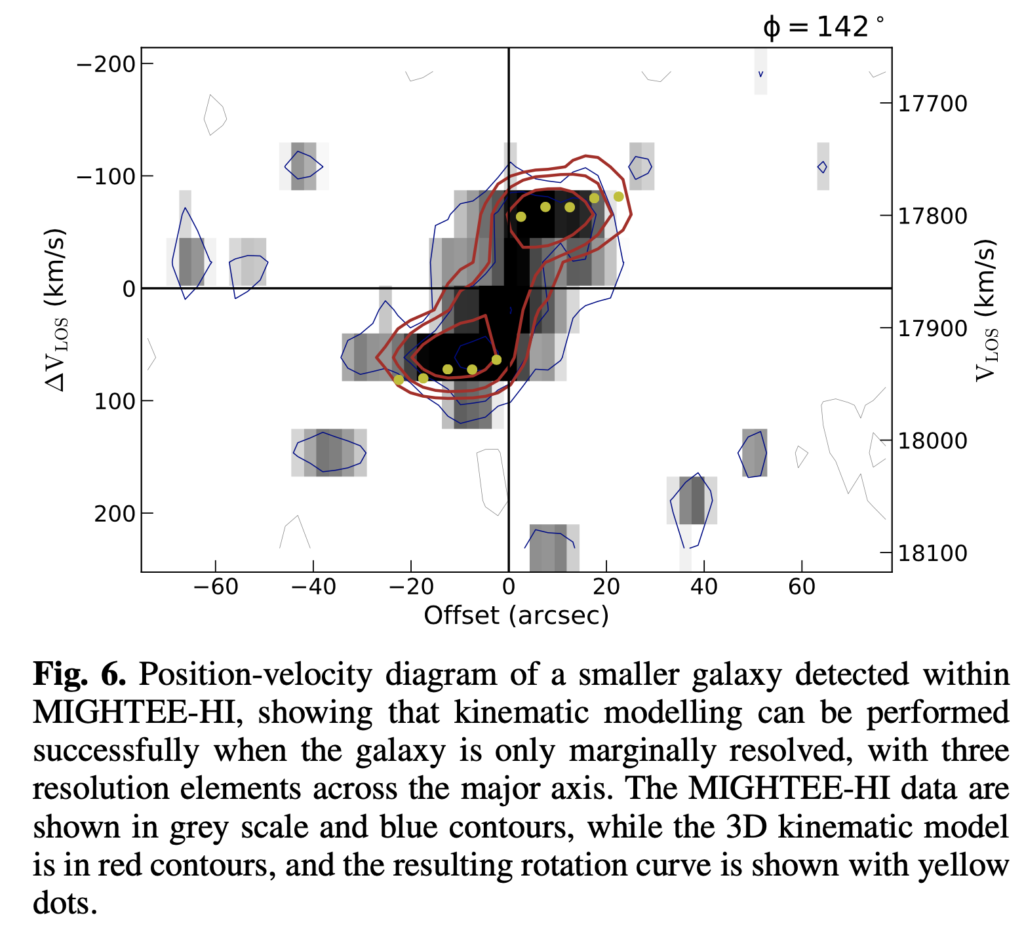In this new paper, the observations of neutral hydrogen in the MIGHTEE survey conducted on the MeerKAT telescope are described. This particular project addresses 10 science questions, which shows the breadth of science that can be carried out thanks to the unique ability of MeerKAT to observe faint neutral hydrogen signals.
Neutral Hydrogen, called HI (H – one) by astronomers, is the most common type of baryonic matter found in the universe. Baryonic, as opposed to dark matter, the nature of which is still being guessed. Therefore, being able to trace it it important to understand many things, from the formation of the first galaxies, to their evolution and details of their dynamics in the recent universe.
The MIGHTEE survey is one of the MeerKAT Large Survey Projects and is allocated substantial observing time on MeerKAT. MeerKAT is one of the most powerful instruments to observe neutral hydrogen and has opened the door to a whole new era of research in the field. The patch of sky that the MIGHTEE survey will observe is also well studies in other wavelengths (e.g. using optical telescopes, infrared or x-ray) and the possibilities offered to better understand what’s going on by combining observations are very powerful. This is what we call multi-wavelength astronomy.
The 10 science objectives of the MIGHTEE HI project are:
- 1 – The HI Mass function: This fundamental quantity describes the distribution of neutral hydrogen within galaxies.While we have a good estimate of it at recent cosmic times, this quantity has evolved over the history of the universe and knowing that evolution is key to understanding galaxy evolution.
- 2 – Kinematics from specially resolved HI. This is the ability to observe how the neutral hydrogen behaves within a galaxy. This helps for two reasons. First, the study of galaxy gas accretion and depletion, which includes minor mergers, pressure stripping, outflows and feedback. Second, the study of galaxy structure and kinematics, which includes warps and lopsidedness, rotation curves and dark matter, and more.
- 3 – The Tully-Fisher relation. This is a correlation for spiral galaxies between their luminosity and how fast they are rotating. In this case, the baryonic TFr, linking the baryonic content of a galaxy to its rotational velocity will be studied with unprecedented detail.

- 4 – HI in Low-mass galaxies. Low-mass galaxies refer to a type of galaxy also known as dwarf galaxies. Dwarf galaxies can provide critical tests of our cosmological understanding. They are also excellent cosmic laboratories for studying galaxy formation. In fact there are many discrepancies between observations of dwarf galaxies and predictions from cosmological simulations based on physical processes. These can be resolved when processes observed in dwarf galaxies, such as star formation feedback are taken into account. Star formation feedback are processes by which the interstellar environment is heated by young, massive stars.
- 5 – Neutral hydrogen as a function of environment. The distribution of HI depends on its environment. In particular, it is useful to study the distribution of neutral hydrogen in clusters of galaxies and the MIGHTEE survey contains a number of clusters.
- 6 – The interface between galaxies and their environment. We know that galaxies, and in particular this in which stars are being formed, cannot be isolated systems as far as their gas content is concerned. One main indication is that the number of stars in observed galaxies would have by far by now absorbed all the gas present in the galaxy. Yet we still observe star formation in galaxies at all stages of our cosmic evolution. There musth therefore be one or more channels though which star forming galaxies acquire new gas. This can be studied with the MIGHTEE- HI project.
- 7 – HI below the detection limit. Science from MIGHTEE-HI is not restricted to direct detections of neutral hydrogen in galaxies. Statistical techniques and multi wavelength observations can be employed to extract information below the limit of direct detection.
- 8 – HI Intensity mapping. This active field of research has been the subject of previous papers, one of which is described here.
- 9 – Scaling relations. Scaling relations, where something scales according to something else, are a common phenomenological tool in astronomy. The Tully Fisher relation described above is one example. But it is not the only one. The HI content of galaxies is a dynamic quantity, and it is important that we are able to observe it as a function of cosmic time. The relation between the neutral content of galaxies and their stellar mass at present times, is complex and non-linear already. At other distances, meaning at other times in the past, the relationship will be different and this project will allow the team to study that.
- 10 – HI in galaxy evolution simulations. Gas flows into and out of galaxies govern their evolution and properties. Observations of neutral hydrogen are particularly good at tracing gas around galaxies. Numerical simulations of galaxy formation and evolution have shown that, it is possible to broadly reproduce the properties of galaxies. MIGHTEE-HI will provide an unprecedented sample of observations for testing such simulations.
With all these science questions being addressed with observations of neutral hydrogen with the MeerKAT, the telescope shows its incredible quality and the research team behind the MIGHTEE-HI project will be kept busy for years to come.
Reference:
MIGHTEE-HI: The HI emission project of the MeerKAT MIGHTEE survey
Natasha Maddox, Bradley S. Frank, A. A. Ponomareva, M. J. Jarvis, E. A. K. Adams, R. Davé, T. A. Oosterloo, M. G. Santos, S. L. Blyth, M. Glowacki, R. C. Kraan-Korteweg, W. Mulaudzi, B. Namumba, I. Prandoni, S. H. A. Rajohnson, K. Spekkens, N. J. Adams, R. A. A. Bowler, J. D. Collier, I. Heywood, S. Sekhar, A. R. Taylor
Top image: MIGHTEE-HI HI total intensity contours, overplotted on the HSC grY image of NGC 895. Contours are at 1×1020, 3×1020, 6×1020, 1×1021, 2×1021, and 2.5×1021 atoms cm−2. The contours in the galaxy centre indicate a depression of H i, also seen in Fig. 5. The H i contours have been smoothed to 20×20 arcsec, and are based on ∼ 12 hours of on- source integration. The scale-bar shows 60 arcsec, while the synthesised beam is 11 × 9 arcsec. The position angle from the modelling in Fig. 5 is marked in cyan.
